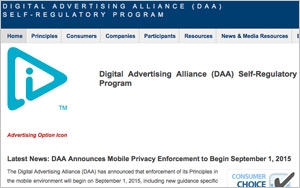DAA Issues Guidelines To Help Brands Understand Ad Obligations
- by Ben Frederick @mp_benfred, November 16, 2015
 The Digital
Advertising Alliance (DAA) has released initial guidance regarding the use of cross-device data gathering and transparency to help companies self-regulate.
The Digital
Advertising Alliance (DAA) has released initial guidance regarding the use of cross-device data gathering and transparency to help companies self-regulate. The new guidance runs in much the same vein as the rest of the DAA’s Principles, ensuring that consumers can make informed decisions around how their data is collected and used, and to whom it is delivered.
The cross-device guidance, called the “Application of the DAA Principles of Transparency and Control to Data Used Across Devices,” is intended to help companies better understand their obligations within the digital advertising ecosystem.
With regard to transparency, when collecting data the guidelines state that it needs to be clear on a company’s Web site or app (through the placement of a “clear meaningful and prominent link to a disclosure”) how data is collected and used; the fact that the data will be connected to another device or browser; and a list of all parties involved with the collection and analysis of data should be included.
Under the guidelines, users should be able to control whether their data can be collected and used from one device to another, and whether that data is given to third parties.
These guidelines will help companies establish best practices in a burgeoning field where lack of transparency and miscommunication to consumers about data usage can be extremely damaging to branding and advertising.
"Lasting consumer relationships with brands are built on trust, and the DAA program builds that trust by giving consumers information and control over the interest-based advertising they receive,” states Thomas Benton, CEO, Direct Marketing Association.
According to a recent survey from Tapad, 79% of consumers ages 18-64 use at least three devices a day, and the average household now owns 5.7 Internet-connected devices.


